By Jeffrey A. Rendall, Photos By Joe McHatton
IJAMSVILLE, MD -- "I told them they were crazy," said P.B. Dye, reflecting back on the day P.B. Dye Golf Club's owners asked him for permission to name their club after him.
Dye continues, "They said they were serious, and were very passionate about it. So, I said, 'I'll tell you what. As long as you keep me involved in the progress of the golf course, and let me overview its conditioning, and as far as making alterations or improvements – as long as I'm involved… and as long as you don't sell it, I'll let you use the name.' I said I'd be honored, flattered. I mean shoot, I was raised on a tractor with a bulldozer and shovel, and all that stuff. To have something like that bear my name, that's really something."
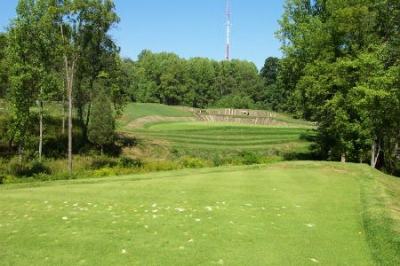 |
| Looking towards the green on the 143 yard 2nd hole, you'll quickly grasp why P.B. Dye Club is different than most courses. |
It's obviously a source of pride, as well as it should be. P.B. Dye Club was the first of several courses to open up in or near the little town of Ijamsville Maryland, but it certainly doesn't take second fiddle to the other quality upscale layouts in the area (meaning Whiskey Creek and Worthington Manor, with Hollow Creek, Maryland National and Musket Ridge just up the road outside of Frederick).
There was an upscale course building boom in the late nineties in this area, as golf course construction slowed to a halt closer in to the Washington DC beltway. Truth is, this little corner in central Maryland has one of the finest concentrations of upscale daily fees you'll find anywhere.
Dye said he loved the project from the very beginning: "The owners found that beautiful piece of property, and said they wanted to build a golf course on 250 acres with those views of Sugarloaf Mountain and no homesites – what more could you ask for? Those guys had a dream. They're both 8 handicappers, and they wanted to build a great golf course. They also liked the things that I came up with, like the waterfall right by the clubhouse, so everything just seemed to fit right in place."
Indeed it does. P.B. Dye Club's developed a reputation as an aesthetically pleasing, yet demanding golf course. There are some design elements there that you likely won't find anywhere else, and it's known for outstanding conditions, tee to green. But it's also developed somewhat of a bad rap. Players have said it was difficult to hold the greens, and sometimes even good shots would roll off into swales and situations they hadn't anticipated being in.
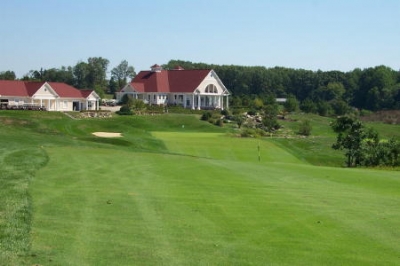 |
| Plenty of fairway on the ninth hole, and the clubhouse presents a nice backdrop. |
The old saying goes, 'It's easier to acquire a reputation than it is to get rid of one,' but they're certainly doing some extinguishing work at P.B. Dye Club. When I played there two years ago, there definitely were some course situations that I would say were unfair, but Dye and the Club's managers are going about fixing them.
Jeff Rosenberg, P.B. Dye Club's Head Golf Professional, elaborates: "We've certainly listened to the comments of our players and changed some things. We eliminated a few bunkers, redid a couple greens – made 'em more reasonable, more receptive. We grew some rough, allowed a higher cut of grass around some of the holes, just so the ball didn't roll down the slopes of the greens as much."
"Everything was done to make the course a little more friendly, so the more difficult up and downs aren't quite as hard," Rosenberg said.
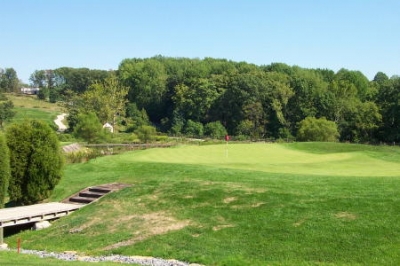 |
| The par four 13th hole's green is almost like an island. If you're not on the green, you're probably in trouble. |
True to his word, the course does play easier. But Rosenberg also says the course has always looked harder than it's played: "You know, it's got a little more flare than the average course, but that's what gives it its character. There're generous fairways and greens here with a lot of different pin placements, and the environmental areas were handled in such a way that they don't really influence play that much."
"We have G2 bentgrass greens, and they're in excellent shape. The green complexes are distinctive with deeper bunkers and railroad ties. The tee shots are pretty tame, with wide fairways – but even though people might say there are some blind shots, there are no tricks to them. You can score well if you're hitting good iron shots, as well as perform in your chipping and putting game. That's where you score here," Rosenberg added.
Adding to the wide fairways is the way they're contoured. Dye says, "I don't know if anybody realizes it, but 12 of 14 fairways are downhill. I've had people tell me they hit the longest drives of their life out there – so while it looks harder than the dickens, it sits really playable. And from the back tees, it's very strong."
Part of the aforementioned 'reputation' surrounding P.B. Dye club was due to its greens. Dye says there's a method behind the madness -- variety: "If you think about 'em, they're all different. Some are dead flat, like numbers four, six, nine and eleven. Others have some subtle contours in 'em, like numbers five, thirteen and sixteen. Then there's twelve, which has more movement than Hurricane Betsy."
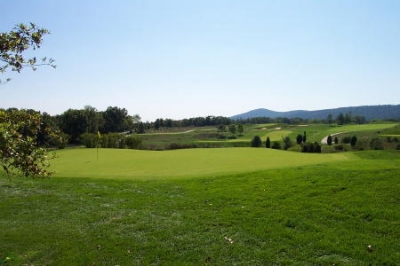 |
| From the back of the 14th green, glance behind and soak in the scenery. |
Hurricane Betsy?
"Dad did a similar green (to twelve) at Crooked Stick. And when they played the PGA Championship there, they just didn't mow the front half, making it a collar. So if you do that, it changes the hole. If you look at that green as two separate greens, the back half and the front half, it makes sense," Dye said.
That's pretty much true of the whole of P.B. Dye Club. Some things that might not initially seem to fit, make a lot more sense once you've played the course a few times, as our playing partner, Tom, pointed out. You've just got to know what club to hit from the tees, and where to place the ball.
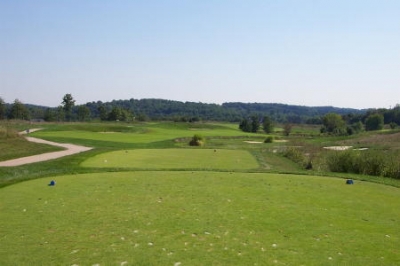 |
| The tee view from the par four 16th isn't as frightening as it used to be, but it's still intimidating. |
P.B. Dye Club also has an interesting local rule, which allows for a free drop if you hit one in the environmental areas. That sure as heck makes a big difference in your score, and will keep smiles on players' faces.
And, as touched on above, P.B. Dye Club is noteworthy for conditioning. Rosenberg says he's proud of it: "Overall, I think our conditioning is up there with the best private clubs. I've gone around on a lot of pro tournaments throughout this summer, and I haven't found greens in better shape than ours – through the drought, anyway. G2 is a warm weather grass, so it likes the heat."
"Having seen the other places, I feel really fortunate being here. Sometimes when you work at 'The Palm' you gotta try steak somewhere else to know how good you have it," Rosenberg quipped.
Looking at the layout, the round starts with some tune-up holes that will lend themselves to good scores to build your confidence, including the third hole, a 535 yard dogleg left par five. Here, a good tee ball will negotiate the trees guarding both sides of the fairway and get some roll down a hill, leaving the green approachable in two.
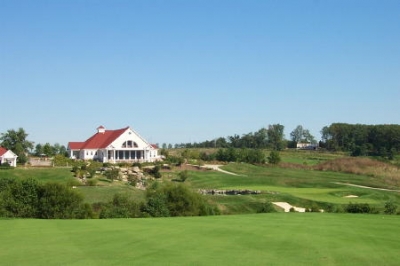 |
| Closing in on the 18th green, you'll have to hit one more target to hedge your bets. |
Four, five and six are demanding par fours. On four, tee over the horizon and hopefully get some good roll over the crest. It'll leave a short iron into the green--but make sure you're accurate — misses are severely punished.
Nine is a great hole to round out the front. 448 from the back, rip the driver to a generous fairway. The second shot, again, will require accuracy. There's a pond on the right side, and a large bunker left. There's also a beautiful waterfall the ninth shares with the eighteenth. Rosenberg says Dye likes to create challenging inward holes, because they often decide the winners of sporting golf matches.
The back nine continues the variety. Thirteen is a great hole. A slight dogleg right, long hitters may try to carry a large bunker that guards the right corner. If they do, the ball rolls down a slope, leaving a wedge into the green. There's a pond protecting the approach to the left, and a bunker guards the right side.
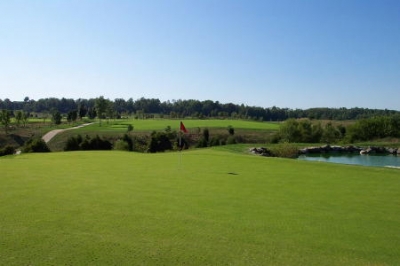 |
| When you're done, take one look back and enjoy the beauty that is P.B. Dye Golf Club. |
Sixteen is a 407 yard par four, again dogleg right. The entire right side is guarded by bunkers, a waste area and railroad ties. Wipe the sweat off your brow and loosen your grip if you want to try and cut the corner.
Eighteen is a great closing hole, and requires a similar type of skill set as the ninth. The challenge is all in the second shot to avoid the pond on the left, and a large bunker to the front right. Quite a finish.
It's probably best to end with a quote by the architect, and the club's namesake: "What we tried to accomplish there, was to build a great 'Nassau' gambling golf course, that everybody can play." Mission accomplished.
Details:
P.B. Dye Golf Club
9526 Dr. Perry Road
Ijamsville, MD 21754
Phone: (301) 607-4653
FAX: (301) 607-4654
Website: www.pbdyegolf.com
Course Designer: P.B. Dye
Head Pro: Jeffrey Rosenberg
| Tees | Yardage/Slope |
| Professional | 7036/143 |
| Gold | 6632/136 |
| Blue | 6292/134 |
| White | 5855/130 |
| Red | 4900/123 |
Rates:
Mon-Wed: $69; Thurs-Fri: $79; Sat-Sun $89.
Twilight rates: $20 off regular rates after 2, Sundays at 1.
All rates include greens fee, cart fee, range balls, and practice bunker. P.B. Dye Club offers unrestricted walking.
| Related Links | Comments on this article? | |
|
Maryland National Golf Club Hollow Creek Golf Club Rocky Gap Resort PB Dye Golf Club in Ijamsville Whiskey Creek Golf Club |
E-mail Jeff Rendall, Editor: jrendall@golftheunitedstates.com |












